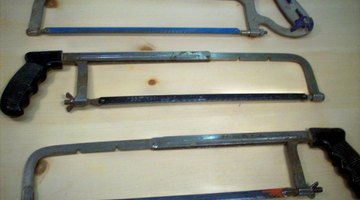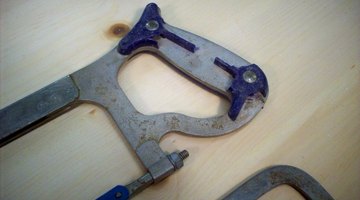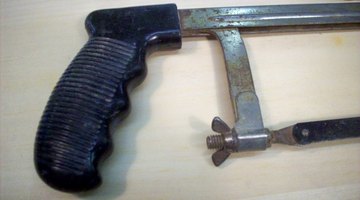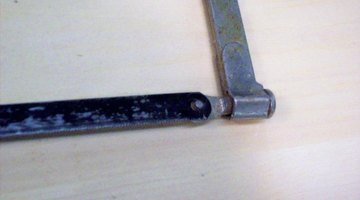Hacksaw Safety Rules
Handsaws are among the easiest saws to use but also can cause lacerations to fingers and hands, and fractures to wrists and arms. The majority of injuries are caused by operator error or inattention. The hacksaw, although smaller than other types of handsaws, is no different.

Handle Inspection

Stress on a hacksaw is substantial. Inspect the handle for cracks, splits and loose parts. If it breaks under stress, the broken edges or parts can cause lacerations to hands or fingers. Immediately replace defective saws.
Tension Is Palabable

Turn the wingnut on some models -- the handle on others -- to apply adequate pressure to keep the blade from moving. After it's secure, turn the wingnut or handle 1/4-to-1/2 turns more to tension it properly. After using the hacksaw for a few strokes, check it again; it may be necessary to turn it 1/4 turn at a time until the blade is stiff and doesn't move. Improper tension can cause the blade to bend or break.
Pins and Teeth

Pins secure the blade. If they're dirty or worn, they can release the blade under pressure, resulting in an accident. The saw should be discarded for a new one if pins are questionable. When installing the blade, the teeth should be pointing forward, or away from you. Hacksaw blades require tension to operate efficiently. The teeth on the blade should be appropriate for the type of material being cut. For example, wood-cutting teeth are wide spaced and tilt from side to side. Metal-cutting teeth are closely spaced with little or no tilt.
Get a Grip

Place the cutting stock in a vice. It should be secure and locked in tight. The cut should be within 1 inch of the vice or closer to prevent the material from wobbling or moving when it's cut. Use both hands, with one at each end of the saw. Cut deliberately forward with a slight downward angle, using the full length of the blade with each stroke.
The Drip Cap
- Handsaws are among the easiest saws to use but also can cause lacerations to fingers and hands, and fractures to wrists and arms.
- Inspect the handle for cracks, splits and loose parts.
- ** Immediately replace defective saws.
- After using the hacksaw for a few strokes, check it again; **it may be necessary to turn it 1/4 turn at a time until the blade is stiff and doesn't move.
- ** Place the cutting stock in a vice.
References
Writer Bio
Specializing in hardwood furniture, trim carpentry, cabinets, home improvement and architectural millwork, Wade Shaddy has worked in homebuilding since 1972. Shaddy has also worked as a newspaper reporter and writer, and as a contributing writer for Bicycling Magazine. Shaddy began publishing in various magazines in 1992, and published a novel, “Dark Canyon,” in 2008.
Photo Credits
- Wade Shaddy
- Wade Shaddy
- Wade Shaddy
- Wade Shaddy
- Wade Shaddy
- Wade Shaddy
More Articles



